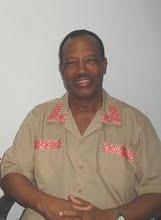Roberto Reid: Panama Historian

Roberto Reid was born in Panama. He went to the USA where he served in the US army and attended graduate school. Mr. Reid came back to Panama to retire. When he returned to Panama he thought about the era around when he grew up, the 1930’s to 1950’s and realized that there was not much written or recorded about that era. Especially there was not much written about his people, the “silver roll people.”
Roberto Reid is descended from West Indian immigrants who came to Panama for work. He grew up in the old Marañon neighborhood of Panama City and in Colon. The “silver roll” reference has to do with the two pay scales in building and maintaining the Panama Canal. White workers were “gold roll” and non white workers were “silver roll.”
Mr. Reid has a web site entitled The Silver People Chronicle and a Spanish Site Rapsodia Antillana. He tells stories or growing up in Marañon, working in Chiriqui, and more. As his site has gathered the attention of other persons “of an age” he receives more stories, filling in the history of Panama in the 1930’s, 1940’s, 1950’s and before.
I sat down with Roberto Reid in the work area of his and his wife’s apartment the other day for a chat. He explained why he started looking into mid 20th century history in Panama. He also told me that his graduate studies in the USA were in Black Studies. “I never had any idea that there was such a thing as black Studies,” he hold me, “until I got to the United States.
“How was the United States compared to Panama?” I asked.
“The biggest shock,” Mr. Reid said, “was being a black soldier in uniform in Delaware and going places with other soldiers who happened to be white.” He was not so much dismayed at being treated differently in the 1960’s in the USA as in the assumption that “this was what was to be expected.” Nevertheless he adapted, went to school after the army and worked as a parole officer and later as a private detective in California. He enjoyed his life in the USA but he and his wife decided to return to their first home when they retired.
Today Roberto Reid tells stories. “My Dad was one of the first in the neighborhood to have a car,” he says. “On day Dad brought home little chicks and put them in a box with a light hanging overhead. He put drops in the water and fed the chicks. When they got too big he took them to Mr. Harry who had cages.” This story continues as chickens hunt for their food in the tall grass during the day and return to the cage at night and it is young Roberto’s job to lock the cage at night. And, of course the land is owned by a man, Gabriel Duque, who had horses, both for pulling buggies and for racing. From there we move on to American servicemen and their girlfriends riding around Panama City in horse drawn carriages.
Mr. Reid can take you through the streets of Panama when everyone called all of today’s Via España, Avenida Central. He recalls how, when he grew up, he spoke Spanish on the streets and English at home with “the old folks.” Roberto Reid remembers when the building housing the Afroantillano Museum was a Baptist church and how he changed churches to find a place where there was more depth to the religious instruction. He was interested, at a young age, in things that people read in English.
As Mr. Reid’s work as progressed he receives calls and visits from US citizens whose ancestors lived and worked in Panama. Nowadays people descended from “gold roll” personnel contact Roberto Reid for help in finding out information about their ancestors.
Each of Mr. Reid’s web sites, http://www.thesilverpeoplechronicle.com/ in English and http://www.rapsodiaantillana.com/ in Spanish is a good and entertaining read. And, if your family has a little history in Panama Roberto Reid is a great source of information.
Mr. Reid is most easily reached by email through his www.thesilverpeoplechronicle.com web site.
